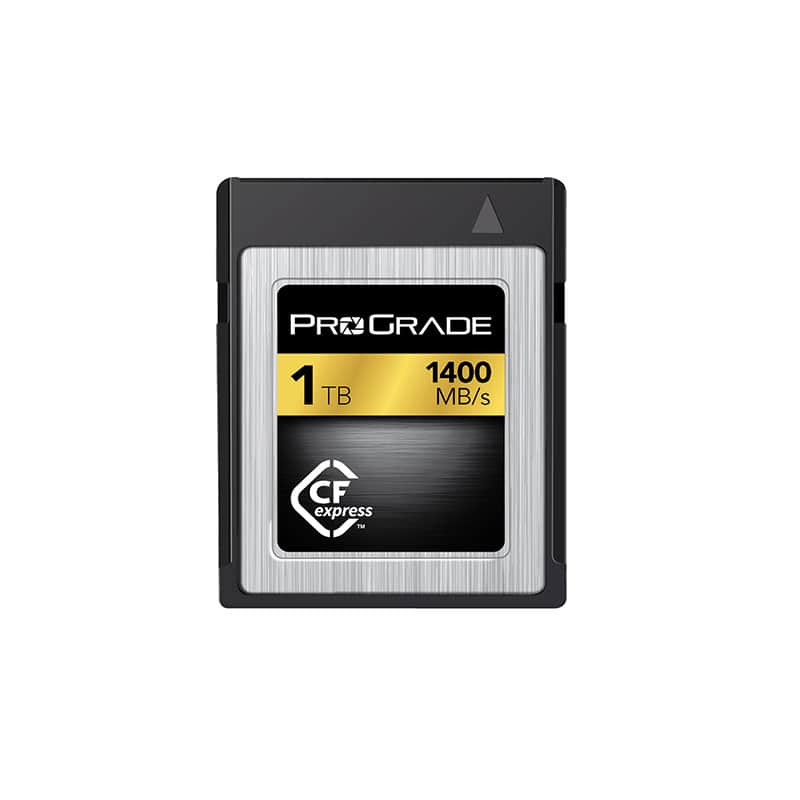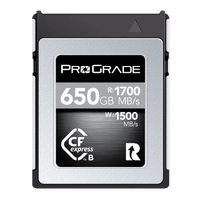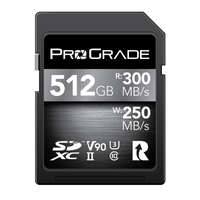Two New Standards Drive The Next Generation Of High Performance Removable Storage
Wes Brewer, CEO ProGrade Digital
Recently, the SD™ Association (governing body for SD card development and standardization) announced finalization of revision 7.0 for the card SD specification. This revision now includes a section 8.0, which adds an NVMe® compliant, PCIe® interface option. Like the announcement of CFexpress™ 1.0 made by the CompactFlash® Association in August of 2016, the PCIe interface with NVMe provides a scalable path for improved performance in flash-based storage devices, and conforms to industry standards in use for devices such as SSDs.
This white paper provides an objective look at variances between the two standards SD Express and CFexpress
SD Cards VS CFexpress Overview
The major differences between the SD Express and the CFexpress standards lie in the number of PCIe lanes, plus the physical form factor for each. As highlighted in an earlier white paper, the CFexpress Type B form factor utilizes two PCIe lanes and has maximum data transfer rate of 2GB/sec.; the SD Express standard utilizes one PCIe lane at maximum data transfer rate of 1GB/sec. The CFexpress Type B form factor is physically compatible with the earlier generation XQD™ standard; the SD Express is physically compatible with the full-size SD standard. In addition to the Type B form factor for the CFexpress standard, single lane Type A and four lane Type C proposals are making their way through the CompactFlash technical committee with anticipated release late 2018/early 2019.
Major Differences Between SD Cards And CFexpress Cards
| CFexpress Type B | SD Express | |
| PCIe Lanes | 2 | 1 |
| Performance | Up to 2GB/sec. | Up to 1GB/sec. |
| Backward Compatibility | XQD 1.0/2.0* | SD UHS-I (SDR 104**) |
| Card Mfg. Royalty | No | Yes; to SD-3C, LLC |
| Size | 38.5mm x 29.6mm x 3.8mm | 32mm x 24mm x 2.1mm |
| Housing | Metal for better heat dissipation | Plastic housing |
* Compatibility in XQD hosts may require firmware upgrade or special device driver.
** SDR 104 and all traditional SD speed classes are optional.
Performance, backward compatibility and physical size are differentiators between the two card types. Royalty paid by SD card manufacturers is another key point: there is a royalty for SD Express, there is no royalty for CFexpress.
Backward Compatibility For SD Standard
During the evolution of the SD product–from version 1.0 of specification (Default Speed) to version 2.0 (High Speed) to version 3.0 (Ultra High Speed UHS I) to version 4.0 (Ultra High Speed UHS II) to version 6.0 (UHS III)–the SD association has attempted to keep successive versions backward compatible. It appears that SD backward compatibility is again supported in the new SD Express standard (version 7.0). This is true to a certain extent; however there are a few areas that could be problematic for users of legacy devices who rely on an SD Express card within an older camera.
For example, as shown in the chart below, it could be problematic to use an SD Express card in a host that requires UHS-II speed. In this instance, SD Express will revert back to a UHS-I speed of 104MB/sec., instead of 156MB/sec. in full duplex or 312MB/sec. in half duplex mode of UHS-II. This problem could be exasperated by the fact that the 104MB/sec. support in UHS I is an optional support speed. Theoretically, an SD Express card could run as fast as 1GB/sec., but would only run at 50MB/sec. in any camera that does not support SD Express natively.
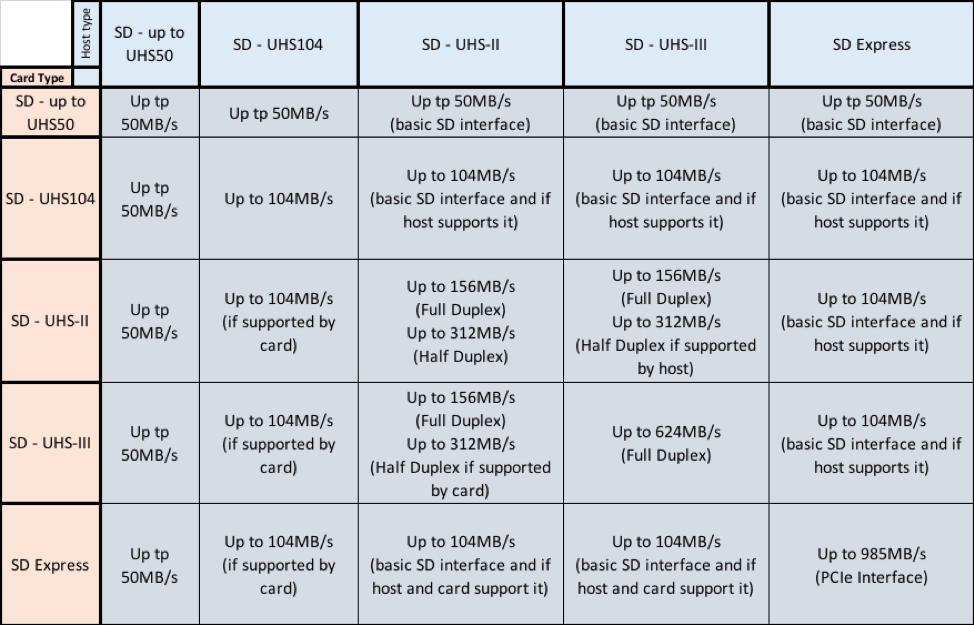
Over the years, the SD Association has also come up with various Speed Class standards and associated logos (see below pictures). The intent of these Speed Classes is to define a minimum write speed for video capture based on requirements of the camera or camcorder to ensure there is no “frame drop” during video recording. Logos were created to make it easier for the consumer to pair the right card to his or her camera.
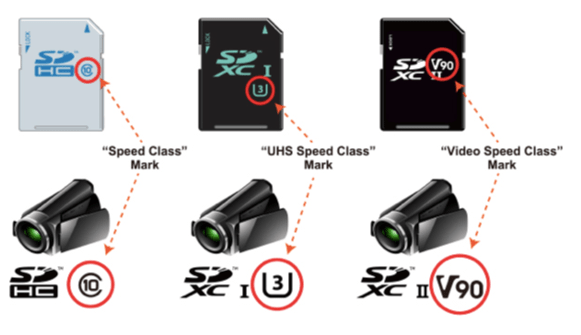
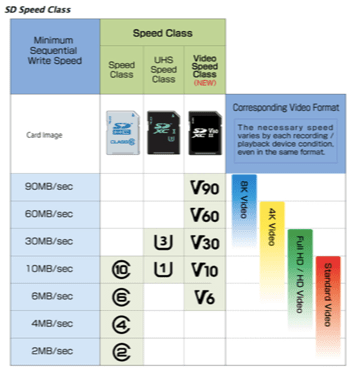
SD Express may have created backward incompatibility issues for some of these Speed Classes. For example, Speed Classes (see above pictures), as defined Speed Class (SC), UHS Speed Class (UHS SC) and Video Speed Class (VSC), are all optional and not required as part of the SD Express 7.0 specification.
- SC comprises the old C4, C6 and C10 designations. There are many older high-end devices that require a C10 speed class rated memory card to record 4K video.
- UHS SC comprises the old U1 and U3 designations. Many devices, such as the Sony® A7R III, require U3 capability to record 4K video.
- VSC comprises the current V30, V60 and V90 video speed designations. Newer devices, such as the Panasonic™ GH5S, require a V90 rated card to support the highest 4K capture
Due to above incompatibility challenges it will be up to the card manufacturers to determine what speed classes to support, certify and define. This may add further confusion for consumers who are trying to assess what to purchase.
Backward Compatibility For CFexpress Standard
Within the imaging industry there is lively discussion over the CFexpress Type B and its potential for backward compatibility within an XQD slot (applies to select Nikon® DSLRs and select Sony pro camcorders). Since a CFexpress card utilizes PCIe, it is possible for certain host cameras to upgrade the firmware and then support the newer CFexpress card, however the card may operate at a slower, single lane speed depending on which version of XQD was originally supported.*** Some camera vendors have adopted a forward-looking approach by incorporating the hardware required to support a dual lane CFexpress card–in the short term supporting XQD through a firmware update only.
*** XQD 1.0/1.1 slot only supports a single lane.
Voltage Support
The new SD Express can also take advantage of 1.8V and future 1.2V operations. These two lower voltage options have viability for mobile applications, but it is not clear which full size SD hosts will take advantage of the low voltage options. The CFexpress card only runs at 3.3V–a standard operating voltage range for removable storage in use for more than 20 years.
Heat Dissipation
The form factor of CFexpress Type B follows the original XQD physical size attributes. This larger form factor offers two benefits. First, its size allows more heat dissipation, but more importantly it utilizes a metal housing which allows heat to be drawn off of the enclosure. This allows the card to run cooler during extended high-speed recording sessions such as 4K RAW video capture (if used with the appropriate heat conducting host connector). The SD express form factor does not offer a provision for extracting heat through a host connector during high-speed operation.
In Summary
There will likely be industry adoption of two PCIe-based removable card standards. Form factor decision will likely be influenced by:
- Performance scalability of 1 or 2 lanes PCIe
- Whether or not a robust and more ergonomically friendly Type B form factor is needed
- Presence or absence of manufacturer royalty
- Necessity of a metal housing (CFexpress) with ability to cool cards that operate within a very high performance envelope of 1GB/second or more
The great news about both new card types is that host device makers and consumers gain a wide choice of high performance storage options. Applications that require a smaller mechanical footprint, and which do not require two lane performance levels, may favor SD Express. For many professionally focused camera applications, the CFexpress standard has a good chance of winning.
Definition Of Terms
| CFexpress Type A |
A single lane PCIe-based memory card overseen by the CompactFlash Association which has proposed outline dimension of 20mm x 28mm x 2.8mm |
| CFexpress Type B |
A double lane PCIe-based memory card overseen by the CompactFlash Association which has proposed outline dimension of 38.5mm x 29.8mm x 3.8mm |
| CFexpress Type C | A quad lane PCIe-based memory card overseen by the CompactFlash Association which has a to-be-determined outline dimension |
| NVMe |
NVM Express |
| PCIe |
Peripheral Component Interconnect Express https://en.wikipedia.org/wiki/PCI_Express |
| UHS |
Ultra High Speed–a specification pertaining to SD cards |
| VSC |
Video Speed Class–a specification pertaining to SD cards |
| XQD |
A type of PCIe-based memory card overseen by the CompactFlash Association |
